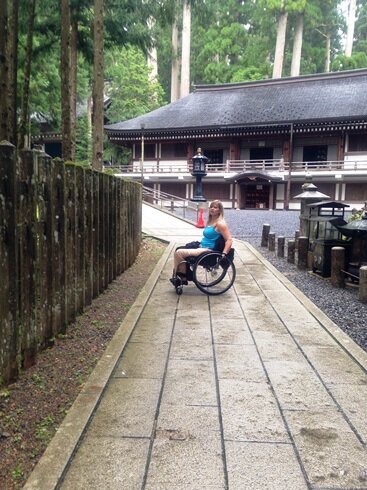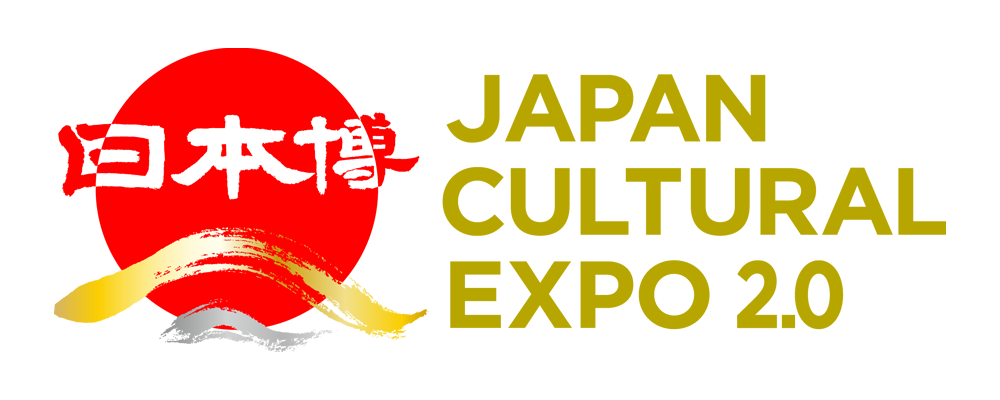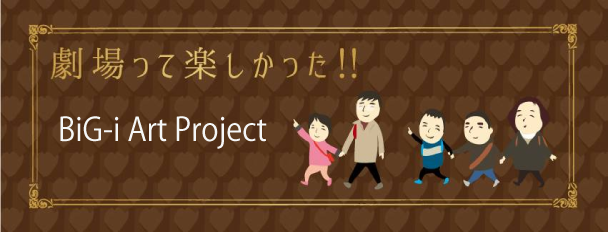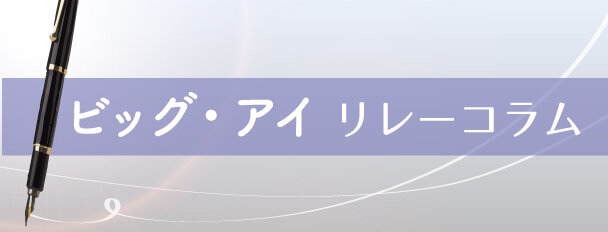国際障害者交流センター(ビッグ・アイ)
国際障害者交流センター(ビッグ・アイ)は、障がいのある方も、ない方も、
すべての人にご利用いただける施設です。障がい者が主役の芸術・文化・国際交流活動の機会を創出し、
障がい者の社会参加促進をめざします。施設内には、多目的ホールや研修室、宿泊室、レストランを備えています。
事業報告・研究
プロジェクト
事業報告

Regan Linton Report / Monking It in Osaka
開催日:2015年 3月 9日 (月)
---

“Monking It” in Osaka
By Regan Linton
I sometimes fancy myself a Buddhist monk. After all, as a wheeler, I spend much of my day seated on a stable base; so do monks. I have a unique perspective on the world that allows a glimpse into deeper truths that hurried-footed folk sometimes scurry past.
Monk. And, my physical existence demands a bit of extra care, attention, and selfawareness, which, balanced with an acknowledgment of the fleeting nature of life, body, and existence, allows me – at some point – to let go of the physical world. Monk, monk, monk.
So when I found myself wheeling through a secluded cemetery atop a mossy mountain in Japan, surrounded by ancient trees, inhaling clean fogs of history and spirit, on sacred grounds that felt countless miles away from the turmoil of the planet, and face to face with a Buddhist monk…I felt at home.
Now, at least at this particular point in life, I am NOT a Buddhist monk. I am an actress, who found herself in Japan in July 2014. My first visit had been in 2006 with a cultural exchange for young people with disabilities sponsored by Mobility International USA; a magical trip of homestaying, exploring the wilds of the Tokyo subway, comparing Japanese and American sign languages, and scything through tall grasses at the Tokyo Wild Bird Park. I left that trip dreaming of an opportunity to return. So when I was invited to present at Big-I – an arts, culture, and communication center for people with disabilities in Osaka – I dove in.
Now, for those who don’t recall grade-school geography, Japan is an island, just east of the Koreas and China, and an 11-hour plane flight west of San Francisco, which is where I began my journey. Unlike my other previous international trips (to Japan, Dubai, Europe, Brazil), this time I would be traveling alone. Which,
inevitably raised the question…um, bathrooming? Upon boarding, they initially offered the on-board aisle chair to wheel me to the bathroom mid-flight. My take on that: big hassle…especially compared to the ease of my mitrofanoff, which allows me to efficiently and somewhatmodestly empty my bladder into bottles via my belly button. I explained the situation to Saki, the flight attendant, who responded that she had no problem assisting my bottleemptying processes. Woohoo, cross-cultural conundrum #1 solved!
Problem #2: An 11-hour flight. We plegics (para, quad, etc) sit. A lot. But, sitting still on a plane is different from being in your custom chair where you can wriggle and weightshift. Personally, I get uncomfortable, even on my personal cushion. So, I employ other strategies including compression socks, massaging my legs,
stretching, and doing yoga moves to prevent leg swelling, skin issues, and discomfort. In close plane quarters, I typically give my seat neighbor a heads up about this squirmy behavior. However, this time I requested at the gate that, if they had any seat with an open space next to it, I’d appreciate being seated there (since, most likely, I’d be the only person on the flight unable to stand up and move around). I ended up with my own row, and could wriggle to my delight. (And by the way, I was NOT the only wheelchair user on the flight…there ended up being 4-6 Japanese wheeling passengers, so I was in good company.) Conundrum #2 solved!
Problem #3: EVERYTHING ELSE in a foreign country where you only speak bits of the language but need to communicate unique and important needs. Yet within minutes of arriving at the gate in Osaka, I was reminded of why I love traveling to Japan: they are ON IT. They are respectful, efficient, and have common sense about things like postflight wheelchair assembly, or engineering stable aisle chairs that don’t topple over in the absence of a buff attendant. (See PHOTO: Why can’t we get these aisle chairs in the United States?) Plus, Japanese culture is one of integrity, friendliness, and respect.
Meaning…people don’t insert themselves when they don’t know the proper assistive technique, or when assistance isn’t needed. I admit that their efficiency sometimes made me feel slightly nervous about taking more time to do things myself, but I never had to contend with someone interfering in the “you look incapable so I’m going to help you even if it results in calamity” kind of way (which often happens in the US).

Within minutes of disembarking the plane, I had visited a fully accessible airport bathroom, breezed through the empty “accessible” customs line, been greeted by my hosts, and loaded into a spotless cab (driven by a white-gloved female cabbie) for the hour-long ride to BiG-i.
BiG-i
As much as I read about BiG-i before arriving in Japan, I didn’t fully understand what it was…mostly because the United States doesn’t really have anything like it. (The Ed Roberts Center in Berkeley is probably the most comparable.) The International Communications Center for People with Disabilities – or “BiG-i” – was established by the Osaka government in 2001 to serve people with disabilities through arts, culture, and advocacy programming, while also providing the local and international community with social service training related to persons with disabilities. On any given day, BiG-i may host a local conference on disaster preparedness, a symphony of schoolchildren invited from Tokyo to perform in the center’s music auditorium, an international artist who is presenting a theatre or dance workshop for people with disabilities, or all of the above.
The BiG-i building includes a state-of-the-art music auditorium, conference/study rooms, a restaurant, and – most uniquely – a “hotel” with 40+ guest rooms, in Japanese and Western style.

And the kicker: EVERYTHING is fully accessible. The seats in the auditorium can be reconfigured to accommodate any number of wheelchairs on the main level (up to 150). It’s a paradise of automatic doors. The public bathrooms are equipped with changing tables large enough to accommodate an adult. The elevators have video screens that show sign language interpreters that echo the auditory announcements. And the guest rooms are an access junkie’s dream: switches within reach, doorbells that also flash ligh when triggered, handrails, wheelchair-level beds, space to maneuver, and a bathroom with numerous grab bars, plenty of surfaces to set supplies, and a shower area that allows for the choice of using the tub or the flat, rollable shower area just beside the tub.
It’s not glamorous, but it doesn’t need to be; as is often the case around Japan, function takes precedence over fancy. This is my kind of philosophy: I could care less about whether a bed is made of hand-carved, gold-inlaid wood that some dude stained with cherries two hundred years ago…if it’s too high for me to transfer, it’s useless. And the Japanese know how to arrange spaces efficiently and rationally: Japan has huge populations living in a limited amount of space (the population density of Osaka-Kobe-Kyoto is 13,900 per square mile, compared to 4,600 in New York). Therefore, their space-utilization techniques often utperform the standards of the ADA, and, frankly, just make more sense (as though the designer has actually thought about what people need, rather than just trying to fit arbitrary code requirements).
BiG-i Director Makoto (Mako-chan) Tsuji – a T-4 paraplegic himself, from a car accident 40 years ago – has personally considered every aspect of access in each cranny of the building. And he’s still not satisfied – the one challenge I had was fitting my padded travel bathroom chair over the Japanese-style wall-mounted toilet, which does not taper inward at the back. He respectfully asked to see the situation himself…I imagine this will be remedied by the next time I visit.

In speaking with Mako-chan, an unassuming businessman, advocate, and former athlete, it’s clear that he realizes one of the biggest challenges for people with disabilities is finding affordable, accessible accommodations. I have found that even in big cities like New York or Los Angeles, accessible and affordable options can be scarce: access = space = hefty pricetags. A person with a need for “barrier-free” (the commonly-used term in Japan) accommodations can stay at BiG-i when visiting the center itself, or when in Osaka for other business or pleasure. BiG-i is also located a few hundred feet from the train station, and multiple barrier-free malls.

It’s no wonder, therefore, that I encountered a wide range of people with disabilities (and their families) at BiG-i. Many of them attended my presentation: folks from an integrated ability hip-hop dance troupe, teachers and personal attendants of persons with intellectual disabilities, and parents…some of whom are still coming to terms with the injuries or conditions that have impacted their children. I spoke about my spinal cord injury and how I rediscovered my life purpose in theatre, ultimately deciding to forge a life as a professional actor. It was an exercise in patience as the talented interpreter restated each of my sentences in Japanese, but the entire audience was incomparably attentive and respectful, even when a loquacious attendee with slow speech decided to share a rather long explanation of her own journey. No one checked their phones or tried to take the microphone away. We all listened.

After the presentation, I spoke with numerous individuals who expressed gratitude for my presence: An older gentleman who had traveled from Hiroshima, where he survived the atomic bomb as a child; a middle-aged man who said he was sorry he could not bring live flowers for me, and had instead compiled an extensive book of rose photographs he had taken himself (the first of countless gifts I would receive on the trip); and a mother who was wrestling with raising a child who, in the eyes of society, was not “normal”. Time after time, it was clear that, despite our inability to speak each other’s languages fluently, we all shared a bond rooted in the social experience of disability that was understood without translation. Even though I was supposed to be the one imparting knowledge, I felt like a student among numerous senseis who were illuminating the true purpose of life. Monk-style.

Beyond BiG-i
A little context about me: I like adventure. Pushing boundaries. Living on the edge. Using every day of my life to explore something different and extraordinary. This doesn’t mean I constantly launch myself out of airplanes; sometimes it’s as simple as trying a food I think I dislike, or speaking impromptu with a friendly stranger, or venturing someplace I could get lost. I’m a libra, so I like to balance the adventure with enough caution to stay alive; living on an edge that has a lip so I don’t go toppling over the side.
As a wheeling traveler, I’ve found I sometimes have to compromise adventure for practicality or safety. I mean, I would love to trek atop a donkey through Arabian sands to Petra, but this level of adventure raises the probability of side hazards, like skin sores from sand-sleeping or undetected bug bites, bowel and bladder infections from lack of sanitary conditions, and general overall physical risk and exhaustion from being in an environment that isn’t built to support the needs of unique bodies. The best wheeler travels, in my experience, provide adventure AND afford the ability to take-care-o’-yo’-stuff in a way that isn’t so complicated that it ruins the experience. For the wheeler who doesn’t want to succumb to perpetual travel on cruises, Japan is a perfect fit: you can find yourself atop a secluded mountain oasis, or inside a giant ancient temple amidst a magical foreign culture, but have arrived there thanks to modern amenities that reduce barriers. With less stress being spent on “how will I get up the mountain into the temple?”, one can focus on the better vacation stressors: “Do I want ramen or okonomiyaki today?!”
This is not to say Japan is infallible on access. Some restaurants and shops are cramped for wheelchairs, some buildings have steps and no ramped entry, and it can be challenging to navigate the subway or other access conundrums (particularly if you don’t speak Japanese). But, for the most part, even in the absence of an impending national law preventing discrimination against people with disabilities (to be fully implemented in 2016), Japan has effectually made the wide majority of public spaces accessible. And again, many things that are engineered with intentions unrelated to accessibility end up being barrier-free due to their functional design. For example, the “Japanese style” door (essentially a sliding pocket door), which is often automatic, allows for space-saving in tight quarters like bathrooms, and is generally easier and safer to open than a swinging door.

When it comes to creating barrier-free zones, Japan takes what I dub the “video game approach.” In America, questions of access often get over-complicated and overthought, which leads to hesitation. If a business has steps and needs a ramp, it can get belabored by: What kind of ramp? How much will it cost? Who is liable? Do we have to change the entire front of the building? Will it be visually appealing? Will the entrance be built to code? Will we get sued? And so on. The result – as I have often seen – is business owners making excuses for NOT making accommodations, which they exaggerate as an overwhelming hassle. Now, the ADA didn’t intend for access to equal hassle; the point was for businesses to make reasonable accommodations, which could mean investing a couple hundred dollars in a modular ramp for a stepped entrance. But fear, litigation, and bureaucracy often get in the way of simple solutions.
In Japan, I don’t feel burdensome. The “video game approach” means that the question of a ramp is as simple as, “Boop boop! Create a little pathway here…beep beep! Lay down a ramp over this crevasse here…bing! Bing! Help push the wheelchair onto the magic mushroom, and DING! Get the princess!” It’s like access challenges are little miniature projects that are treated with levity, efficiency, and duty…not feigned difficulty and patronizing attitudes (which has too often been the case for me in America). And frankly, it takes all of 30 seconds for the svelte subway station attendant to ask which stop you’re getting off, and to grab the temporary metal ramp and pop it over the subway platform gap. Or, for the restaurant owner to grab a washcloth and wipe down a person’s wheels so that dirt isn’t tracked into a shoe-free restaurant.

And many of these solutions abound in Japan. The subways are nearly all navigable for wheelers. Ancient temples in Nara have ramps that allow wheeling entry to sacred spaces. And one of my favorite experiences – the UNESCO World Heritage Site of Koyasan – has lifts, ramps, and attendants that assist in getting on the steep trolley car that ascends to the top of the mountain. Once there, accessible paths guide you through sacred cemeteries rich with Japanese history, and temples where monks from a millennium ago are still believed to be inhabitants. The journey requires stamina, and taking the train from Osaka made for a long day of travel. (There are lodgings at the top of Koyasan, but I did not get to evaluate their accessibility.) But the journey is worth the long trip, and for a short while I was able to envision myself as a wheeling samurai who had sojourned to dabble in the monk’s life.

Other enjoyable side trips included a visit to Fukuju Sake Brewery in Kobe, complete with delicious sake tasting; a visit to the Tenjin Festival, celebrating traditional deities with costumes, food, fireworks, games, and more; and a show at the National Bunraku Theatre, where artists bring ancient stories to life through precise manipulation of classically handcrafted puppets…one of the most masterful and impressive storytelling forms I’ve ever seen.

And of course, the FOOD: okonomiyaki, ramen, rice, fish, pickled vegetables, miso, tofu, tea, omrice, rice crackers, pork buns, beer, teriyaki, sushi, and more…I couldn’t get enough of the traditional Japanese cuisine. Plus, for the brave-stomached, you can witness vendors in the markets prepare eels, fish, and other delicacies right before your eyes, from the tank to the table.

I learned after my trip that there is an unfortunate Japanese word that has come into existence in the last couple of decades: karoshi. Literally translated it means “death from overwork,” and is used in relation to people who die suddenly due to physical stress, heart attack, stroke, or other physical problems resulting from the long working hours that are common in Japan. It’s a devastating phenomenon that has resulted from the intense Japanese work ethic that, ironically, was likely the main factor in Japan’s progress and prosperity after World War II.
At times during my visit, I could sense sadness or exhaustion behind the stalwart cordial smiles of my Japanese hosts. And I certainly wondered if they ever went home to sleep, as they were constantly working, moving, and doing everything they could for me. So perhaps, like most countries – or people – there is a more melancholy side to Japan that wasn’t conspicuously apparent during my visit. Maybe it’s what I sensed amidst the weighty serenity at Koyasan.
This is what I love – and respect – about Japan: there is deep truth, meaning, and heart in its places, its people, and its lives. But, Japan has learned not to take itself too seriously; it balances the depths with a cute, well-functioning, cartoonish surface. People are committed to moving, going, and doing, without getting hung up on themselves.
There’s a quiet pride that is evident: in the language (words for “excuse me” and “thank you” are most commonly used), in the clean subways that don’t smell like pee or trash, in the delicate eating. It’s well-engineered and efficient, with miniature spaces, miniature plants, miniature items. Smooth and automated. With an awareness of what deserves reverence and permanence, balanced with what is fleeting and relinquishable. An acknowledgement of significance and insignificance…and simultaneous respect for both.

I was enlightened about the insignificance of material things in Japan. During my trip, I decided not to pay extra for service to use my phone. And, I limited my use of e-mail. Surprisingly, while I was in one of the most technologically advanced societies on the planet, I enjoyed a technological reprieve that reminded me to breathe and enjoy the delightful video game around me. When I returned to my bedroom in Los Angeles, even my limited possessions felt like extraneous clutter. I was overwhelmed by the junk, the stuff, the noise. In my cupboards, on Facebook, on the freeways, in my e-mail. I was eager to simplify, and let go of some things I’d been holding on to.
What I retained was gratitude: for the generosity of the Japanese people; for a global society that allows us to adventure beyond our comfort zones; and for the reality that Japan is not a fantasy El Dorado that can only be reached in my dreams. It’s a lovely country, accessible to walkers and wheelers alike, where I hope to return one day to satisfy my inner monk.

Contact
お問合せ
障がい者の文化芸術活動及び鑑賞に関するご相談・
事業・ホームページ・情報紙に関するお問合せ
072-290-0962
受付時間:平日 10:00~18:00






